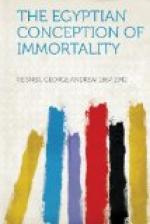In the Sixth Dynasty, there is a return to the older practice of placing objects in the grave itself. At present we are unable to point out the reasons for this. Possibly experience had taught men that endowments and craved walls left to the care of descendants were insecure supports for a life after death which was to last forever. At any rate, the custom arose of making small models in wood or stone or metal of those scenes and objects which were carved in relief on the walls of the chapel, —models of houses, granaries, of kitchens, of brickyards; models of herds and servants and soldiers; models of boats and ships; models of dance-halls with the man seated drinking wine, around him musicians, before him dancing girls; models of swords, of vessels, of implements. Poorer people must be contented with poorer things, down to the peasant who is buried with the few little necessary pots and pans of his daily life. But always, in every grave, the chapel, small or great, is there. The endowment of funerary priests continues. Every man, I suppose, however poor, had some one to make at least one offering at his grave. And so it was down to the New Empire.
VI. THE MIDDLE EMPIRE
During the Middle Empire, the burial and offering customs show the persistence of the old belief in life after death as on earth. Pots, vessels, tools, weapons, ornaments, clothing, and models of scenes from life, continue to be placed in the burial chamber. The walls of the offering chambers of the nobles, at this time cut in the rock, still bear representations from life carved in relief. The symbolical doors and the offering formulas still mark the spot where the dead receive the necessities of life from the living. All graves of every class testify to the faith in a life after death similar to life on earth. Yet certain modifications are apparent which are significant for the future development of the conception of immortality: (1) the pyramid texts are used by the provincial nobles for their own benefit; (2) Abydos assumes a great importance as the burial place of Osiris; (3) the swathed mummy comes into general use in burials.
The first identification of the king with Osiris in the pyramid texts marks the conception of a better immortality for him. So, as the possibility of a better immortality was claimed by wider and wider circles of men, the use of the pyramid texts, or similar texts, also became wider. In the Middle Empire, texts practically identical with the pyramid texts, but furnished with illustrations somewhat like those of the later books of the dead, are found in the coffins of provincial nobles.




